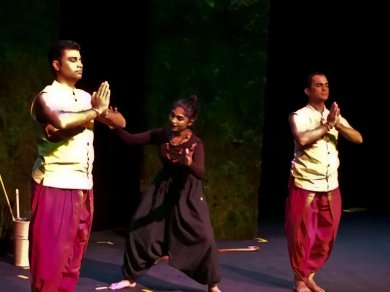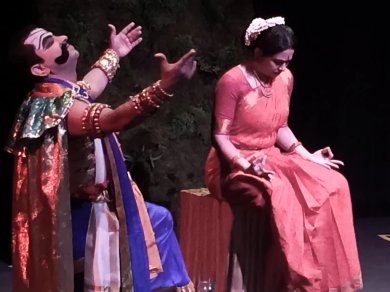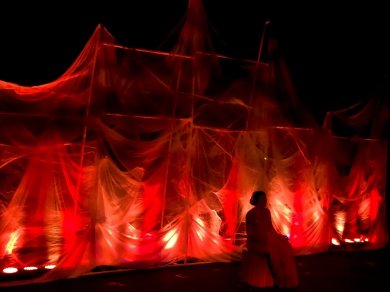
|   |

|   |
Sitayascharitam Mahat - Indeed! - Poornima Ramaprasad e-mail: poornima@sbcglobal.net December 9, 2016 Ramayana in any form is the nectar for life. I have had the greatest privilege of listening to grandmother's story telling, which gave me a great fascination towards this epic. I have never missed an opportunity to watch Ramayana staging that I've had access to - be it a television production, a stage production in the form of pure music, pure dance, musical, Yakshagana or simply story telling. Bay Area recently witnessed another experimental production of this mighty epic in the extravagantly theatrical way called Opera. Opera is typically a western genre of stage play in which the artists perform a dramatic work with a combination of dialogues and musical score, in a theatrical setting. This production, based on original operatic work of Tiruvaiyaru S.R. Krishnan, was beautifully tailored to give a wholesome portrayal of Ramayana, giving dimensions from significant female characters namely the bewildered Kaikeyi, the wretched Manthara, the vile Shurpanaka, the sagacious Trijata and of course, wrapped around Sita, the epitome of virtue. The narrative started with Sita being in Ashokavana and pondering on how all the misfortune befell upon her, while Ravana is still trying to coax her to be his. The kaala chakra moved back to the time when Kaikeyi is delighted at the news of Rama's coronation. Manthara poisons her mind that Rama will be the king and her own son Bharata will be a mere servant to Rama. Manthara fills Kaikeyi's mind with jealousy and succeeds in convincing her to ask for a boon to banish Rama for a fourteen year exile while her own son Bharata should be the crowned prince. One thread that is often told says despite Kaikeyi's love for Rama and the fact that she was Dasharatha's favorite queen, she was always envious of Kausalya and that envy played in her demands. Dasharatha had no choice but to agree with her and banish Rama. The next act showed how Shurpanakha, Ravana's sister, while wandering in the woods of Panchavati was instantly attracted to the youthful looks of Rama. She immediately decides that her demon form would be a hindrance to approach the godly Rama and takes on the form of a beautiful damsel. She approaches Rama seeking his love, while Rama laughs scornfully saying he had a wife and that his brother Lakshmana would make a better match for her. While she tries to persuade Lakshmana, he also rejects her. The rejected and angry Shurpanakha advances towards Sita, when Lakshmana intervenes and chops off her nose. Wild with anger, she takes on her real form and flees to Lanka. 

The part of the story when Shurpanaka seeks help from her brothers Khara and Dooshana, who are also destroyed by Rama and finally goes to Ravana, who in turn takes the help from Maricha asking him to take the form of the magical deer was told by the sutradara and the narrative ended with Maricha who was being pursued by Rama, shouting ‘Ha Lakshmana, Ha Sita’ in Rama's voice, leading Sita to think that Rama was in trouble. Again, focusing back on Sita, the story continues with Sita, in agony, ordering Lakshmana to pursue Rama, much against his will. When Lakshmana leaves Sita behind at Panchavati and goes in search of Rama, Ravana, the demon king of Lanka, enters in disguise as a sage and begs for alms. When Sita advances to give him food and take his blessings, he gains his demon form and tries to coax Sita to become his queen to which the angry Sita says that she is the beloved of Sri Ramachandra, who is virtuousness personified and that his immeasurable prowess will destroy Ravana and his entire demon clan. At this the angry Ravana drags Sita and takes her with him. At this point, the narrative comes back to the present, where Sita was in the Ashokavana lamenting on her ill fortune, when the rakshasi Trijata, who is supposedly Ravana’s agent meant to convince Sita to marry Ravana comes to meet Sita. Instead of glorifying Ravana per his orders, Trijata consoles Sita and tells her about her dream where Rama and Lakshmana came to Lanka and took Sita away after overpowering and killing Ravana. Sita takes her to confidence and tells her how she wishes that the dream came true and if it does, Sita ensures peace and happiness to Trijata and other Rakshasis. The narrative ends with Hanuman going to Lanka, meeting Sita in Ashokavana, convincing her that he is not a rakshasa trick himself and setting fire to Lanka when his tail was set on fire, by which time, Rama and Lakshmana come to Lanka and take over to destroy Ravana and save Sita.  Gargi Panchangam as Sita made it appear like Sita really visited us in the Bay Area. She is a beautiful dancer, actor, musician par excellence and has perfect expressions with a great costume and makeup sense. She carried the role of Sita with virtue and zest. She also did justice to the role of Shurpanakha disguised as the damsel wooing Rama-Lakshmana brothers. Alamelu Iyengar as Manthara took us back to Treta yuga indeed, because she beat all the imagination the audience could have of that role. The young Kanchana Parameswaran as the vile Shurpanakha and Sindhu Singh as both Kaikeyi and Trijata were good, so were all other characters that supported these lead female roles. The most eye catching scene was that of a playful young Hanuman as well as the dialogues between Sita and the mature Hanuman. Hanuman setting fire to Lanka was spectacular and took the audience to the level of cheering Hanuman as he destroyed Ravana's ego. Music by Padmapriya Parameswaran and team was good. Shlokas from Valmiki Ramayana were used aptly in several situations. Singing of Hanuman Chalisa in praise of Hanuman when he was in action gave a fulfilling feeling to the habit of singing Hanuman Chalisa. The narrators adding commentary between scenes, sometimes cynical, sometimes spiritual or more practical would definitely add value to the new audience of Ramayana. This event was supported by Asian Art Museum in San Francisco and so, between each scene a few of the exhibits were brought on stage and explained. It was amazing to see Ramayana paintings as understood by artists across the world. There were exhibits from Indonesia, Thailand, Germany, etc and most of them showed some very specific depiction. Some were very true to the story, while some were artists’ imagination, none-the-less the thought of Ramayana being studied across the world by artists and scholars in indeed heartwarming. Overall, it was a great experience for the viewers. They staged two shows at the Lohman Theatre in Foot Hill College, Los Altos, for a house full audience no less. As we see, the narrative covered the entire Ramayana focusing on select female leads, which is another novel concept. Sitayascharitam Mahat – Great is the glory of Sita. Indeed! With such experimental productions, may the rest of the world, particularly the west, become aware of out great immortal epics. Kudos to Paramesh Gopi and Priya Parameswaran. They were instrumental in conceiving this unique production and taking Ramayana to another stage. Poornima Ramaprasad follows Indian classical music and dance forms. She reviews Indian dance and drama events in the San Francisco Bay area from time to time. |